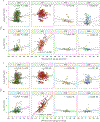Deep learning-based brain age prediction in normal aging and dementia
- PMID: 37118071
- PMCID: PMC10154042
- DOI: 10.1038/s43587-022-00219-7
Deep learning-based brain age prediction in normal aging and dementia
Abstract
Brain aging is accompanied by patterns of functional and structural change. Alzheimer's disease (AD), a representative neurodegenerative disease, has been linked to accelerated brain aging. Here, we developed a deep learning-based brain age prediction model using a large collection of fluorodeoxyglucose positron emission tomography and structural magnetic resonance imaging and tested how the brain age gap relates to degenerative syndromes including mild cognitive impairment, AD, frontotemporal dementia and Lewy body dementia. Occlusion analysis, performed to facilitate the interpretation of the model, revealed that the model learns an age- and modality-specific pattern of brain aging. The elevated brain age gap was highly correlated with cognitive impairment and the AD biomarker. The higher gap also showed a longitudinal predictive nature across clinical categories, including cognitively unimpaired individuals who converted to a clinical stage. However, regions generating brain age gaps were different for each diagnostic group of which the AD continuum showed similar patterns to normal aging.
© 2022. The Author(s), under exclusive licence to Springer Nature America, Inc.
Figures

















References
-
- Harman D Aging: overview. Ann. N. Y. Acad. Sci 928, 1–21 (2001). - PubMed
-
- Courchesne E et al. Normal brain development and aging: quantitative analysis at in vivo MR imaging in healthy volunteers. Radiology 216, 672–682 (2000). - PubMed
-
- Good CD et al. A voxel-based morphometric study of ageing in 465 normal adult human brains. Neuroimage 14, 21–36 (2001). - PubMed
-
- Sowell ER et al. Mapping cortical change across the human life span. Nat. Neurosci 6, 309–315 (2003). - PubMed
Publication types
MeSH terms
Grants and funding
LinkOut - more resources
Full Text Sources
Medical
Miscellaneous

